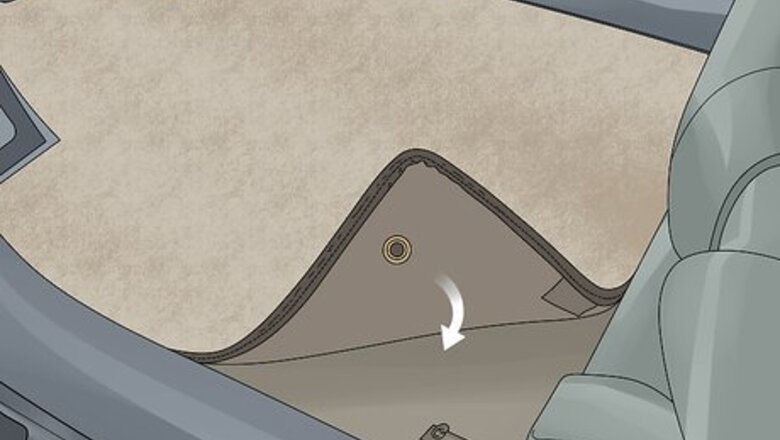
views
Attaching Car Mats to the Floor
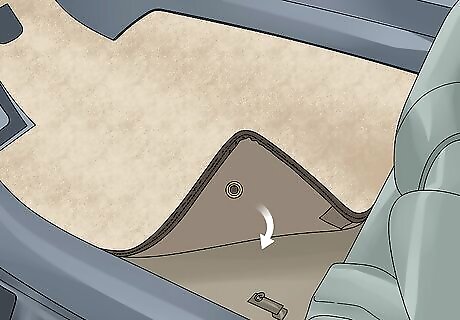
Secure the mats with built-in hooks or fasteners if your vehicle has them. Check on your vehicle’s floor near the front of the seat to see if there are hooks or snap fasteners built into it. If your floor has hooks, push them through the holes in the floor mat so they hold tightly. If there are snap fasteners, line up the other sides of the fasteners on your floor mat and push down firmly until they click into place. If your floor mats don’t have holes, then you can either use a hole punch or hole cutter to make them. Make sure to position the hole so it lines up with the floor mat. Some older vehicles may not have floor mat hooks or fasteners.
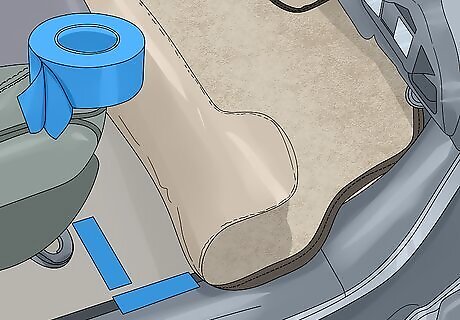
Apply double-sided carpet tape around the underside of the floor mat. Flip the mat over so the bottom is face-up. Cut strips of double-sided carpet tape that are the same lengths as the edges of the floor mat. Remove 1 side of the adhesive backing and carefully place the tape around the mat’s edges. After you apply all the tape, remove the second adhesive backing and flip the mat over. Position the mat in your vehicle and press around the edges firmly to secure the tape. You can buy double-sided carpet tape from home improvement and hardware stores. You can use carpet tape in vehicles that have hard floors as well.
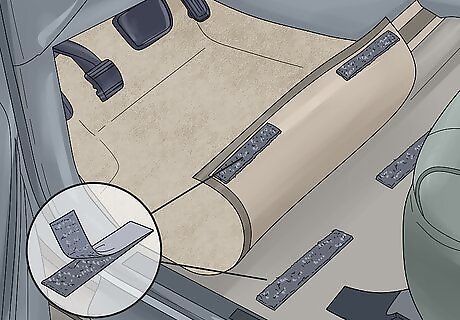
Try putting Velcro on the floor mat and floor to keep it from moving. Look for heavy-duty Velcro strips that have adhesive backing so they’re easy to install. Take 4 pieces of Velcro with stiff bristles and press them into the corners of the floor mat. Set the floor mat inside your vehicle and mark where the Velcro pieces line up. Place the Velcro strips with the soft bristles on the vehicle’s floor. Set the mat down so the Velcro pieces line up and press firmly. You can buy heavy-duty Velcro pieces from your local hardware store. You may also put Velcro strips completely around the edges of the mats for added security, but they may become difficult to remove. If your vehicle has carpeted floors, you only need to apply the stiff-bristled pieces to the floor mat since they will adhere to the carpeting.
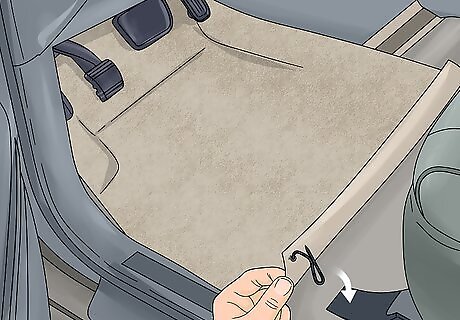
Pin floor mats with holes to carpeted floors using drapery hooks. Lay the mat in the footwell and make marks on the floor where the holes in the mat line up. Remove the mat, and hold a drapery hook so the top of the U-shape points toward the seats. Push the straight, pointed end of the hook horizontally into the mark on the floor to secure it. Repeat the process with the second hook. Put the mat back into your vehicle so the hooks loop through the holes. The drapery hooks will keep the mat from moving forward, but the hooks may slide out if you forcefully move the mat backwards. Drapery hooks have a straight pointed section and a large U-shaped hook, which is normally used to hang curtains on rings or rods. You can buy drapery hooks from a home goods or fabric store. Drapery hooks may damage the carpeting if they’re pulled too hard, so be careful not to shift the floor mat too much.
Installing Floor Mat Anchors
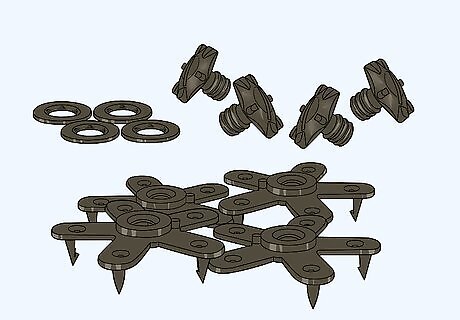
Get a floor mat anchor kit from a hardware store. Floor mat anchor kits are universal, so choose whichever design and color you want to use. Make sure the kit contains a top anchor cap, a spiked anchor bottom, a hole cutting tool, and a washer. Get enough kits so you have 2 anchors for each mat in your vehicle. Most floor mat kits come with 2–4 anchors and cost about $15–20 USD. Floor anchors work best on vehicles that have carpeting in the footwell.
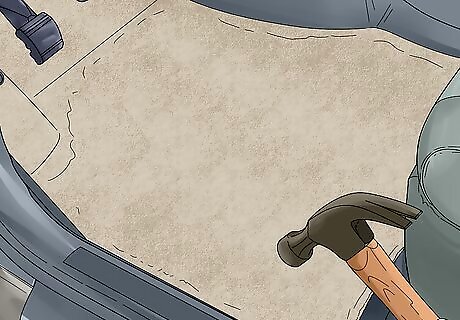
Knock on the footwell with a hammer to find spots that make a hollow thud. Remove the floor mat and lightly tap along the floor along the front edge of the seat. Listen for a hollow thud and check that the carpet bows down when you hit it, which signifies there’s padding underneath. Look for 2 spots near the corners of the seat and mark them with a pen. If you hear a solid metallic sound when you hit the floor, avoid putting the anchor there since you could cause it to break.
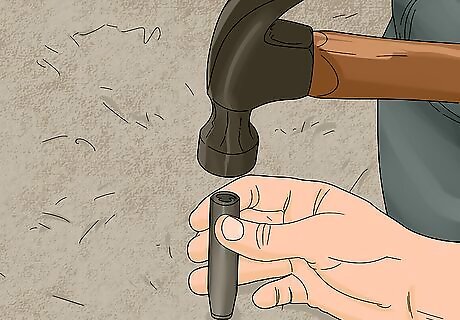
Cut holes in the mat’s back corners so they’re 2 in (5.1 cm) in from the edges. Flip the mat over so the bottom faces up. Hold the hole cutter vertically so it’s 2 inches (5.1 cm) in from the mat’s bottom corner. Tap the top of the hole cutter with a hammer to punch through the mat. Then punch a hole in the other bottom corner the same way. If your floor mat already has holes near the corners, then you may skip this step. You can also twist the hole cutter clockwise to trim through the mat.
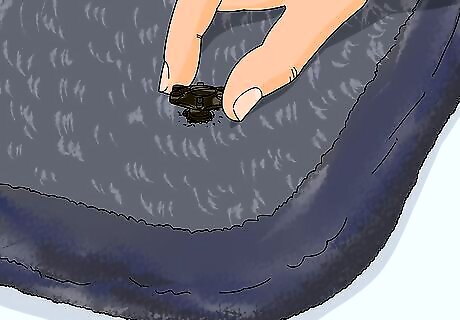
Push the anchor caps through the top side of the mat. Locate the anchor caps, which resemble large plastic screws. Flip the mat so it’s face-up and guide the threaded end of the cap through the hole you just punched. Put the second cap in the other hole on the mat. Press firmly until the bottom of the cap is flush with the mat. The hole will be about the same size as the threaded end of the cap, so it may take a little force to push them completely through.
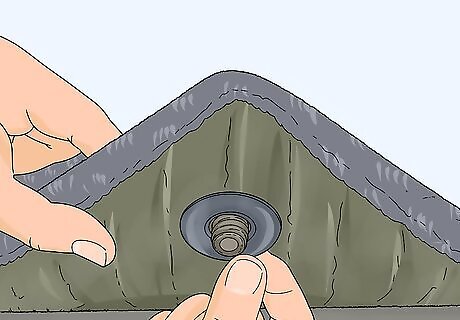
Slide the washers onto the anchor caps’ threadings. Locate the circular washers inside the kit and take 1 for each of the caps. Push the washer onto the threaded end of the washer on the bottom side of the mat. Slide the washer up until it’s flush with the mat. Repeat the process for the other anchor cap. The washer makes it easier to screw and unscrew the cap later on so your floor mats don’t get stuck inside your vehicle. If your floor mat already had holes that have rubber backings, you don’t need to use the included washer.
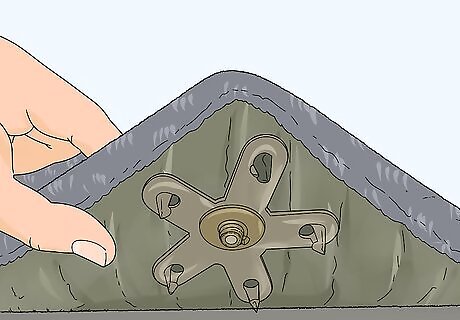
Screw the bottom sections of the anchors onto the caps. Take the bottom portions of the anchors, which look like a star with spikes sticking out from the bottom. Line up the center of the bottom piece with the threading on the cap so the spikes point down. Turn the bottom piece clockwise to tighten it onto the cap until it’s hand-tight. Attach the other bottom piece to the second cap. The pointed ends of the anchor are sharp, so be careful when handling them.Tip: If there are spikes or grippers in the way of the anchor piece, cut them flush to the bottom of the mat with a pair of wire cutters. Then screw the bottom anchor piece in.

Place the mat in the footwell so the anchors line up with the padded areas. Lay the mat down on the floor in the position where you want it. Adjust the mat as needed until the anchors are directly above the sections of floor you marked earlier. Avoid putting the anchors anywhere else on the floor, or else you may break them when you try to secure them.
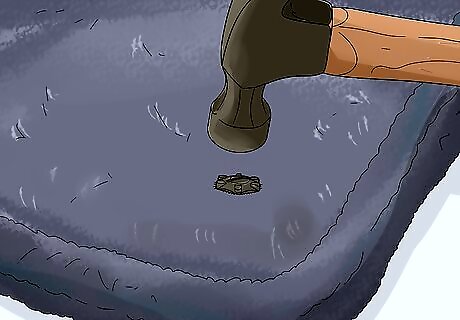
Hit the anchor caps with a hammer to secure them in place. Line your hammer up with the top of the cap and tap it straight down into the floor. Continue hitting the cap until the anchor underneath the mat presses firmly into the flooring beneath it. Then tap on the second anchor repeatedly until the mat lies flat. Your floor mat will no longer move around as you get in and out of the vehicle. You can also stomp on the anchor with your foot to press it down into the flooring. The anchors will cut holes in the carpet underneath the mat, so it may damage the interior if you try to take them out.
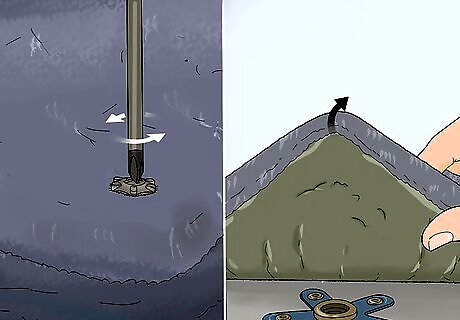
Unscrew the caps whenever you want to remove the mat. Use a screwdriver to turn the caps counterclockwise to loosen them from the anchors. Pull the mat out of the vehicle whenever you need to clean or work on your vehicle. When you’re finished, put the mat back and screw the caps back into the anchors in the floor. The caps will not fall out of the mat because the washers hold them firmly in place.
Buying New Mats
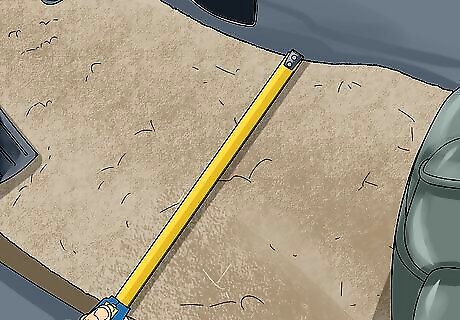
Measure the size of your old floor mats so you know what to get. Use a tape measure to find the length of your floor mat at the longest and shortest sections. Then find the width of the mat the same way. Write down your measurements so you don’t forget them while you’re shopping for new mats. The mats for your driver, passenger, and back seats may all vary slightly, so be sure to measure each one. If your vehicle doesn’t have any mats, then measure the length and width of the footwells with a tape measure.Variation: You can also trace your old mats onto a sheet of butcher paper. Cut out the template, fold it, and bring it with you when you shop to visually compare the sizes.
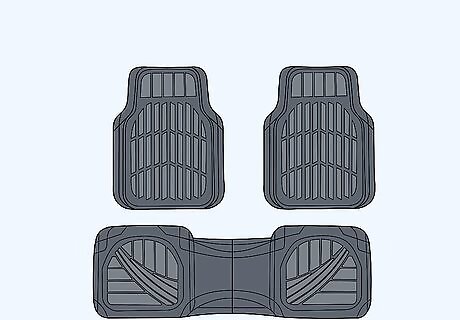
Pick floor mats that match the color or design of your vehicle’s interior. Take pictures of the inside of your vehicle so you can reference their colors. Opt for floor mats that have the same or similar tones so they look cohesive in your vehicle. If you’re unable to find matching floor mats, opt for something clear or black since they’re neutral colors and tend to match most vehicles. You may need to order floor mats online if you can’t find floor mats that are the same color in stores. You may also get floor mats that have designs, such as words or sports logos, molded into them to personalize your vehicle more.
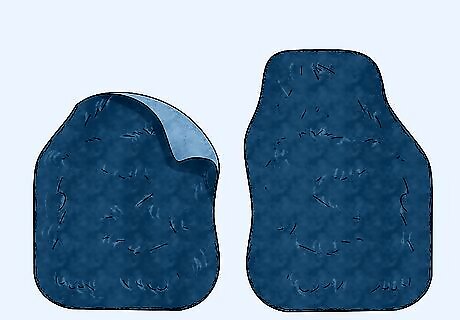
Use carpet or vinyl mats with anti-slip backing for a more decorative look. Check the backs of the mats to make sure they have plastic spikes or rubber grippers that prevent them from slipping around in the footwell. Make sure the floor mats match the sizes of your old ones so they fit properly in your vehicle. Carpet tends to get dirty easier than other styles of floor mats.
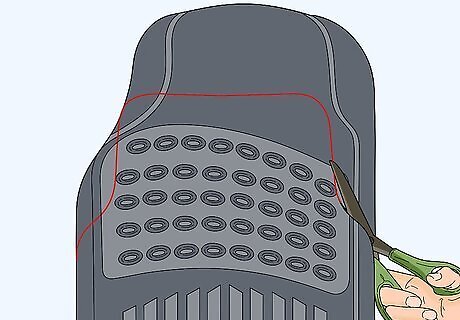
Trim universal rubber mats to size with a pair of scissors for a durable option. Universal rubber mats come in one size, but they have segments you’re able to cut off to make them fit. Lay your old floor mat on top of the rubber one and trace around it with a marker. Slowly cut around your outline with a pair of scissors to ensure it fits properly. Rubber floor mats are thick and water-resistant so they’re easy to clean. Since rubber mats are thicker, they may be more likely to get caught on the accelerator pedal. Be sure to leave a 2 in (5.1 cm) between the mat and the pedal.
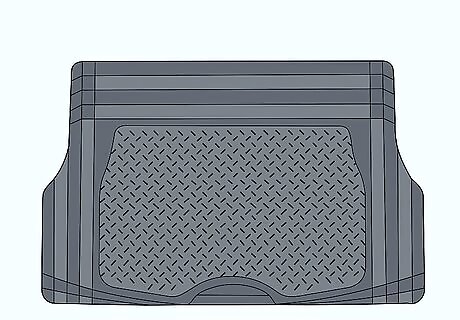
Install all-weather mats molded for your vehicle to cover the entire footwell. Look for all-weather mats that are made for the year, make, and model of your vehicle, or else they may not fit properly. Move the seats and pedals back as far as they can go so you can easily position the mat inside your vehicle. The mat will press against the sides of the footwell so it doesn’t slip around. All-weather mats are heavy-duty and easy to clean, but they can also be the most expensive style. You can buy all-weather mats from specialty automotive stores or online.


















Comments
0 comment